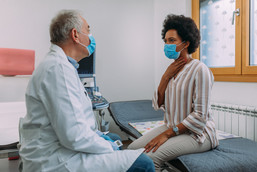| May 3, 2022, Issue #813 In 2019, the top 1 percent of people who spent the most on their healthcare accounted for about 21 percent of total healthcare expenditures, while the bottom 50 percent accounted for only 3 percent of expenditures. (Source: AHRQ, Medical Expenditure Panel Survey Statistical Brief #540, Concentration of Healthcare Expenditures and Selected Characteristics of High Spenders, U.S. Civilian Noninstitutionalized Population, 2019.)  A new AHRQ challenge competition invites participants to develop innovative video content to update the agency's TeamSTEPPS training program resources. Phase 1 of the competition calls for contestants to submit a written narrative on how to update a current TeamSTEPPS video in an equitable, culturally sensitive and health-literate manner. Ten contestants selected to advance to Phase 2 will develop replacements for existing TeamSTEPPS videos. Up to 10 $10,000 prizes will be awarded to Phase 2 contestants who produce successful videos. Winners will be announced by the end of 2022. TeamSTEPPS promotes effective teamwork, collaboration and communication in healthcare while focusing on strategies and tools to improve staff performance, patient safety and quality of care. Access more information about the TeamSTEPPS challenge and previous AHRQ competitions. | Despite longstanding patient safety concerns, an AHRQ-supported study in The Journal of Patient Safety found no evidence of the so-called "July Effect," an increase in patient safety and adverse events after the annual summertime resident changeover. Among nearly 200,000 patient records abstracted and analyzed using the Medicare Patient Safety Monitoring System, changes in adverse event risk at major and minor teaching hospitals and non-teaching hospitals in July and August were not statistically significant. Researchers noted that there have been numerous changes in care delivery in teaching hospitals since the 1990s that may have mitigated the "July Effect," including the presence of hospitalists and changes in intensive care staffing. Access the abstract.  Women who participate in the federal Special Supplemental Nutrition Program for Women, Infants, and Children (WIC) are at lower risk of preterm birth and giving birth to low-weight infants, according to a new report from AHRQ. The systematic review, developed by the agency's Evidence-based Practice Center Program, also found that children who participate in WIC are more likely to have better diet quality, greater intakes of 100 percent fruit juice and whole-grain cereals, and age-appropriate shifts from whole milk to lower-fat milk. Evidence was low or insufficient on other outcomes, however, including whether either maternal or child participation in WIC was associated with child mortality and morbidity. WIC was established in 1974 to safeguard the health of low-income women, infants and children up to age 5 who are at nutritional risk. It provides nutritious foods to supplement diets, nutrition education and referrals to health and other social services. Access the AHRQ report. |  Two AHRQ-funded articles in the Journal of Patient Safety examine issues around definitions and reporting standards for diagnostic safety. In one article, researchers tested the usability of AHRQ's draft Common Formats Event Reporting for Diagnostic Safety Events to help healthcare providers identify and report missed opportunities in the diagnostic process in a standardized manner across healthcare settings and specialties. They concluded that this initial evaluation provided support for its validity and usability, an important first step toward implementation of a new and comprehensive set of data elements for diagnostic safety event information. In another article, researchers explored how an accepted definition of diagnostic error from the National Academies of Science, Engineering, and Medicine (NASEM) is operationalized. They concluded that NASEM created a common understanding of diagnostic error that includes accuracy, timeliness and communication and catalyzed the use of patient-centered concepts in the definition. | AHRQ's Patient Safety Network (PSNet) highlights journal articles, books and tools related to patient safety. Articles featured this week include: Review additional new publications in PSNet's current issue or access recent cases and commentaries in AHRQ's WebM&M (Morbidity and Mortality Rounds on the Web). In a new Request for Information, AHRQ invites comments to inform the development of a potential Consumer Assessment of Healthcare Providers and Systems (CAHPS®) survey to assess patient experience in inpatient mental healthcare settings. Specifically, AHRQ seeks comment by July 1 on methodologically sound survey and data collection approaches and any unique considerations or concerns associated with the collection and use of these data. Access the Federal Register Notice for more information. | AHRQ in the Professional Literature Two data-driven approaches to identifying the spectrum of problematic opioid use: a pilot study within a chronic pain cohort. Schirle L, Jeffery A, Yaqoob A, et al. Int J Med Inform. 2021 Dec;156:104621. Epub 2021 Oct 15. Access the abstract on PubMed®. Framing benefits in decision aids: effects of varying contextualizing statements on decisions about sacubitril-valsartan for heart failure. Thomson MC, Allen LA, Halpern SD, et al. MDM Policy Pract. 2021 Jul-Dec;6(2):23814683211041623. Epub 2021 Oct 18. Access the abstract on PubMed®. Health care professionals' perspectives on universal screening of social determinants of health: a mixed-methods study. Kostelanetz S, Pettapiece-Phillips M, Weems J, et al. Popul Health Manag. 2021 Oct 25. [Epub ahead of print.] Access the abstract on PubMed®. Factors affecting primary care physician decision-making for patients with complex multimorbidity: a qualitative interview study. Schuttner L, Hockett Sherlock S, Simons C, et al. BMC Prim Care. 2022 Feb 5;23(1):25. Access the abstract on PubMed®. A Comprehensive Unit-based Safety Program to improve perioperative efficiency in adolescent idiopathic scoliosis. Raman DL, Bixby EC, Wang K, et al. J Pediatr Orthop. 2022 Mar;42(3):123-30. Access the abstract on PubMed®. Patient experience with in-person and telehealth visits before and during the COVID-19 pandemic at a large integrated health system in the United States. Hays RD, Skootsky SA. J Gen Intern Med. 2022 Mar;37(4):847-52. Epub 2022 Jan 4. Access the abstract on PubMed®. Identifying over-the-counter information to prioritize for the purpose of reducing adverse drug reactions in older adults: a national survey of pharmacists. Martin BA, Breslow RM, Sims A, et al. J Am Pharm Assoc. 2022 Jan-Feb;62(1):167-75.e1. Epub 2021 Aug 23. Access the abstract on PubMed®. Collaborative design and implementation of a clinical decision support system for automated fall-risk identification and referrals in emergency departments. Jacobsohn GC, Leaf M, Liao F, et al. Healthc. 2022 Mar;10(1):100598. Epub 2021 Dec 16. Access the abstract on PubMed®. Contact Information For comments or questions about AHRQ News Now, contact Bruce Seeman, (301) 427-1998 or Bruce.Seeman@ahrq.hhs.gov. |





No comments:
Post a Comment